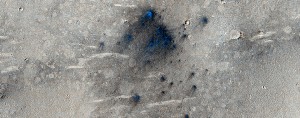NASA’s Mars Reconnaissance Orbiter (MRO) sweeps around the red planet, equipped with a number of specials sensors.
New images of the region northwest of Gale Crater, the landing site of the Mars Science Laboratory (MSL) rover, Curiosity, have revealed a cluster of small impact craters.
Spotted by MRO’s Context Camera on Mars it is suspected that the cluster was produced by the impact of MSL hardware onto the surface of the planet. Those features were likely created back during Curiosity’s landing in August of last year.
“Shotgun blast”
The impact cluster is not as fresh as those imaged earlier by MRO and has been degraded somewhat by winds from the northeast.
The University of Arizona’s operates MRO’s High Resolution Imaging Science Experiment (HiRISE) camera.
MRO team member, Paul Geissler, said that the cluster is about 70 kilometers away from the rover landing site.
With a close-up image, Geissler said that the features were produced by a “shotgun blast” of at least 40 individual impacts that formed small craters no larger than 2 meters in diameter.
Challenging puzzle
But assigning each of the impacts to specific pieces of hardware is a challenging puzzle, Geissler says.
It is thought that the four large craters were produced by two large tungsten weights that broke in half to make these four craters, or by pieces of the cruise stage, which was designed to break up in the atmosphere for planetary protection purposes, to kill any Earthly microbes, Geissler notes.
In cruise configuration, the MSL jettisoned two 75-kilogram tungsten blocks just before atmospheric entry, used as cruise balance masses.
The cluster imaged adds to the mystery, the imaging expert adds, and may have been produced by a piece of the cruise stage that travelled farther through the Martian atmosphere and was therefore more thoroughly fragmented by the time it crashed onto the surface.
By Leonard David

